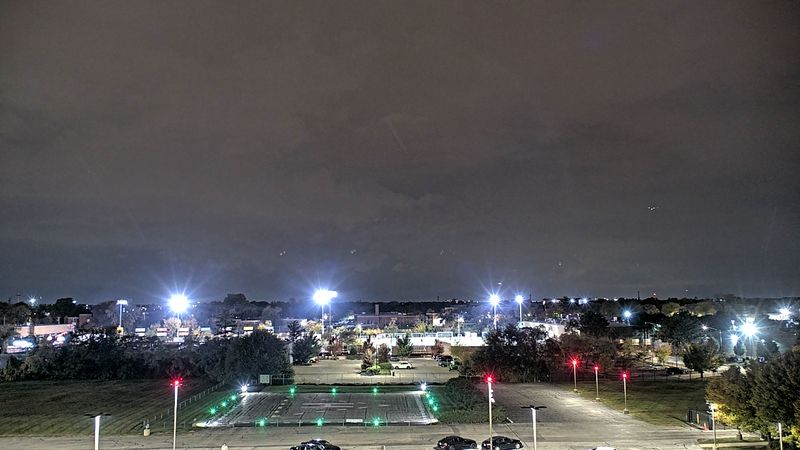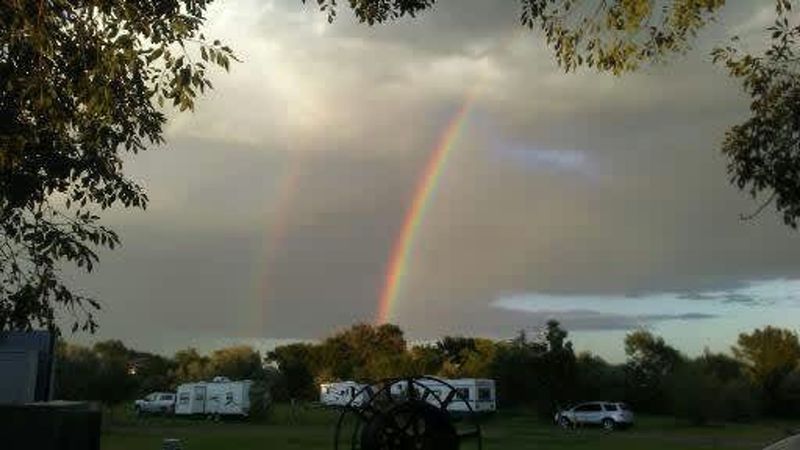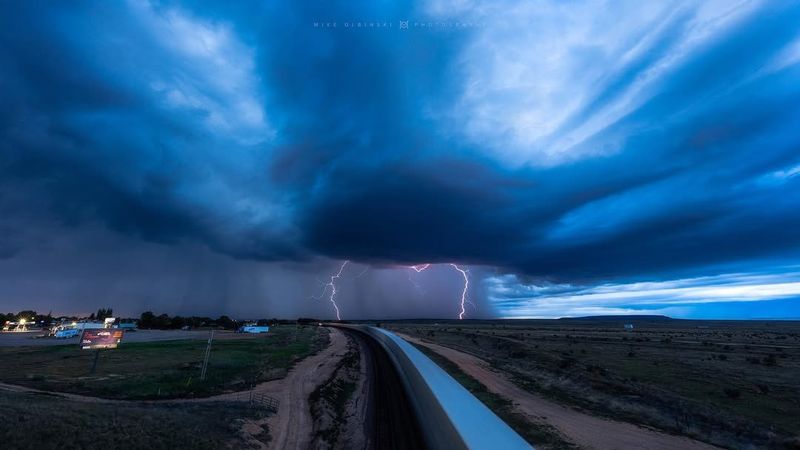New Mexico holds a special kind of magic in its quietest corners. While bigger cities buzz with activity, some smaller towns move at a slower pace, offering wide open spaces and endless starry skies instead of crowded streets.
These places might not have flashy attractions or busy nightlife, but they shine in their own way when the sun goes down and the desert sky lights up with countless stars.
If you’re looking for peaceful moments and natural beauty instead of constant excitement, these towns offer something truly special.
1. Carrizozo

Carrizozo sits quietly along Highway 54, where tumbleweeds sometimes outnumber cars on the main road. Population hovers around 900 people, and most businesses close up by early evening. The town feels frozen in time with its historic storefronts and wide, empty streets that seem to stretch forever under the desert sun.
But when darkness falls, something magical happens here. Without city lights competing for attention, the Milky Way stretches across the entire sky like a glowing river of stars. Locals and visitors alike pull over on quiet roads to simply look up and marvel at the celestial show.
The nearby Valley of Fires Recreation Area offers even darker skies for stargazing adventures. Ancient lava fields create dramatic silhouettes against the starlit backdrop. Carrizozo may move slowly during daylight hours, but its nighttime beauty makes the peaceful pace feel perfectly intentional and wonderfully rewarding for patient souls.
2. Roy

Way up in the northeastern corner of New Mexico, Roy exists as one of the state’s most remote communities. Fewer than 250 residents call this prairie town home, surrounded by endless grasslands and big sky country. Daily life revolves around ranching and agriculture, with little else to occupy your time besides watching the horizon.
Entertainment options? Practically nonexistent. Shopping choices? Even more limited. Yet Roy possesses something money cannot buy in busier places.
The night sky here explodes with brilliance once the sun disappears below the flat prairie landscape. Zero light pollution means every constellation appears crisp and clear, from the Big Dipper to Orion’s Belt. Shooting stars streak across regularly during meteor showers, and the International Space Station passes overhead like a slow-moving beacon.
Visitors often spread blankets in open fields and spend hours counting satellites and identifying planets. Roy’s extreme quietness becomes its greatest treasure after dark.
3. Logan

Logan hugs the shores of Ute Lake in northeastern New Mexico, home to roughly 1,000 residents who enjoy fishing and not much else. The town itself offers minimal attractions beyond a few convenience stores and basic services. Most days pass quietly with little happening beyond the occasional truck rumbling through on the highway.
Ute Lake State Park nearby provides the main reason people visit this area. Boating and fishing occupy daylight hours, but the real spectacle begins after sunset.
Standing on the lake shore at night transforms your perspective completely. Stars reflect perfectly on the still water surface, creating the illusion of floating between two identical skies. The effect feels almost surreal, like stepping into a cosmic mirror.
Photographers travel considerable distances to capture this double-sky phenomenon. The combination of dark skies and reflective water creates opportunities for stunning night photography that simply cannot exist in brighter, busier locations across the state.
4. Mosquero

With barely 100 people living here, Mosquero ranks among New Mexico’s tiniest incorporated towns. Located in the high plains region, it features little more than a post office, a community center, and scattered homes spread across the windswept landscape. Excitement runs pretty thin when your nearest neighbor might live a mile away.
The town’s name supposedly comes from the Spanish word for mosquito, though you’ll find more wind than bugs these days. Historic buildings stand as reminders of busier times when the railroad brought more activity through town.
Today, Mosquero’s isolation creates perfect conditions for astronomical observation. The surrounding plains stretch flat and dark in every direction, providing 360-degree views of the night sky. Amateur astronomers sometimes make pilgrimages here specifically for the exceptional visibility.
On clear nights, you can see the Andromeda Galaxy with your naked eye. The zodiacal light appears regularly, and satellite trails cross overhead constantly, reminding visitors of our connected world above.
5. Des Moines

Tucked into the northeastern mountains near Colorado, Des Moines serves about 140 residents who appreciate solitude. This former mining town sits at high elevation, where thin air and cool temperatures define the climate year-round. Modern amenities remain scarce, and entertainment options basically don’t exist beyond conversation at the local cafe.
Historic buildings recall busier days when mining operations brought prosperity and population. Now, quietness reigns supreme as the primary characteristic of daily life here.
The elevation advantage pays huge dividends for stargazers, though. Higher altitude means less atmosphere to look through, resulting in sharper, brighter stars than lower elevations provide. Constellations appear more vivid, and planets show greater detail even to modest telescopes.
Mountain silhouettes frame the night sky beautifully, creating natural borders for the celestial canvas above. Cool evening temperatures make extended stargazing sessions comfortable, especially during summer months when lower elevations feel oppressively warm. Des Moines trades excitement for extraordinary astronomical views without regret.
6. Grenville

Grenville occupies a remote spot in the far northeastern corner where New Mexico meets Texas and Colorado. Around 35 people live in this agricultural community surrounded by endless plains and big ranches. The town consists of a few buildings clustered together, offering minimal services to the scattered population living in the surrounding countryside.
Boredom comes naturally when your town lacks restaurants, shops, or any form of organized entertainment. Days pass slowly with little to mark one from another.
Yet Grenville’s extreme remoteness creates some of the darkest skies in the entire state. Light pollution remains virtually nonexistent, allowing the full glory of the cosmos to reveal itself nightly. The Milky Way casts actual shadows on the ground during moonless nights, a phenomenon most people never experience.
Deep sky objects like nebulae and galaxies appear surprisingly bright and detailed. Even modest binoculars reveal cosmic wonders that remain hidden in brighter locations. For astronomy enthusiasts, Grenville represents a hidden treasure worth the long drive through empty countryside.
7. Folsom

Folsom gained fame in archaeological circles when ancient spear points were discovered nearby, proving human presence in North America thousands of years ago. Today, about 60 residents live in this quiet community where history feels more present than modern conveniences. The town moves at a pace that feels almost prehistoric itself, with minimal activity and even less excitement.
Visitors come mainly for the small museum documenting the famous archaeological finds. Otherwise, there’s little reason to stop in this sleepy spot along the highway.
When darkness arrives, though, Folsom connects you to both ancient and cosmic history simultaneously. Standing under the brilliant stars, you can imagine early peoples looking up at these same constellations millennia ago. The timeless quality of the night sky bridges past and present beautifully.
The surrounding landscape remains largely unchanged from ancient times, enhancing this connection to history. Modern light pollution hasn’t reached this remote area, preserving night skies that early inhabitants would still recognize today as familiar and magnificent.
8. Cimarron

Cimarron carries Wild West history in its bones, once hosting famous outlaws and frontier characters in its heyday. Today, around 900 people live in this mountain town where the pace slows considerably compared to its rowdy past. Historic buildings line the main street, but modern entertainment remains limited to exploring local history and enjoying natural surroundings.
The town sits nestled in a valley surrounded by mountains, creating a peaceful but somewhat isolated atmosphere. Quiet evenings arrive early here.
Those mountains that create daytime isolation also frame spectacular night skies perfectly. The valley position blocks distant light sources while the high elevation enhances star visibility remarkably. Camping areas near town offer prime stargazing locations with mountain silhouettes adding dramatic foreground interest.
Philmont Scout Ranch nearby attracts young visitors who often experience truly dark skies for the first time in their lives. The combination of historic atmosphere and astronomical beauty gives Cimarron a unique character that transcends its daytime quietness. Stars have witnessed this valley’s entire colorful history.
9. Corona

Corona sits in central New Mexico’s high plains country, home to roughly 180 people who embrace the ranching lifestyle. The town spreads out along Highway 54, offering basic services but virtually no entertainment or attractions. Wide open spaces surround this community in every direction, creating a sense of isolation that some find peaceful and others find stifling.
Daytime hours pass slowly with little to occupy visitors beyond perhaps grabbing food or fuel before continuing their journey elsewhere.
But Corona’s location in the middle of nowhere pays astronomical dividends after sunset. The high elevation combined with distance from any cities creates exceptionally dark conditions. Stars appear so numerous they almost blur together into a continuous glow across certain parts of the sky.
The surrounding plains provide unobstructed horizons, allowing you to watch stars rise and set in ways that mountains or buildings elsewhere prevent. Meteor showers become particularly impressive here, with shooting stars visible from horizon to horizon throughout the night. Corona’s boredom transforms into cosmic theater regularly.
10. Vaughn

Vaughn grew up as a railroad town in east-central New Mexico, currently home to about 450 residents. The community sits at the junction of two highways in flat, open country where strong winds blow almost constantly. Modern Vaughn offers little to travelers beyond basic services, with most people passing through rather than stopping for any length of time.
The town’s flat surroundings and aging buildings create an atmosphere of faded importance from busier railroad days. Entertainment options remain practically nonexistent for locals and visitors alike.
Yet this same flatness and remoteness create outstanding conditions for observing the night sky. Without terrain features blocking views, you can see stars all the way to the horizon in every direction. The effect creates an immersive experience like floating in space itself.
Train whistles occasionally echo through the darkness, adding a lonely but romantic soundtrack to stargazing sessions. The combination of vast skies, distant trains, and endless stars captures something essentially New Mexican that busier places cannot replicate or fake convincingly.
11. Encino

Encino barely registers on most maps, with a population hovering around 90 people scattered across the high plains of central New Mexico. The town consists of a handful of buildings along the highway, serving the ranching operations that dominate this sparsely populated region. Visitors find almost nothing here beyond a place to pause briefly before moving onward.
The surrounding landscape stretches flat and mostly empty, with more pronghorn antelope than people occupying the countryside. Boredom comes standard in this extremely quiet community.
But Encino’s extreme isolation and tiny population mean light pollution simply doesn’t exist here at all. The night sky appears exactly as nature intended, filled with thousands of visible stars creating a breathtaking celestial display. The Milky Way stretches overhead with stunning clarity, revealing details invisible in brighter locations.
Standing outside at night, you can hear absolute silence broken only by occasional coyote calls in the distance. This combination of visual and auditory peace creates a meditative experience that feels increasingly rare in our busy modern world.
Dear Reader: This page may contain affiliate links which may earn a commission if you click through and make a purchase. Our independent journalism is not influenced by any advertiser or commercial initiative unless it is clearly marked as sponsored content. As travel products change, please be sure to reconfirm all details and stay up to date with current events to ensure a safe and successful trip.